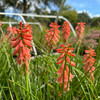

WELCOME BACK!
Our earliest available ship date is the week of April 14th.
Please note your preferred ship date/week in the "Order Comments" section at checkout.
See the "Shipping" page under "Company Information" for our default ship dates based on hardiness zone.
We are unable to ship to any US Territories, AK, AZ, CA, CO, HI, ID, MT, NM, NV, OR, UT, WA, or WY
Delicate and exotic looking cinnamon red flowers with short, narrow, grassy leaves. This compact plant is suitable for smaller gardens or smaller beds.
Free blooming and re-blooming. Loved by hummingbirds!
Blooming Time: June to October (with the peak in early to mid summer)
Size: leaves 16"/ 24" with flowers ' tall x 12-14" wide
USDA Zones: 6-9
Culture: full sun, half sun, adaptable to soil conditions, prefers neutral to slightly acidic soil and somewhat drained (or well draining soils) - this can prevent potential damage in winter. Average, loamy and also poor quality soils (gritty, rocky, sandy, infertile). In zone 6 some drainage (sand, gravel soil amendment) is recommended.
Moisture Needs: medium-dry, medium is the best, but established plants are drought tolerant.
Origin: red hot poker originates in the mountain meadows of South Africa. 'Redhot Popsicle' was introduced by Terra Nova nurseries in Oregon, it is part of Kniphofia POPSICLE™ Series. Plant is patented under PP24036 (EU38283), unlicensed propagation is prohibited.
Black walnut tolerant: seems like yes (so far what we have experiences)
Deer/Rabbit Resistant: yes / yes
Attracts Butterflies or Pollinators: not confirmed
Attracts Hummingbirds: yes
Pot Size: square 3.5" x 4" deep perennial pot (quart)
Plant combinations: Flower beds in sun, cottage gardens, naturalistic, tropical, eclectic, deer resistant plantings, naturalistic gardens, cut flower gardens, or drier edges of rain gardens (or swales). Tolerates salt, so suitable for coastal areas.
You can use it with plants requiring drier or average conditions. Looks great with blue or purple colors of Agastache, Catanache caerulea, Eryngium, Nepeta, Linum lewisii, Platycodon, Scabiosa, Veronica or reblooming Salvia nemorosa hybrids. But can be combined with many plants on the average to drought tolerant scale like Achillea, Artemisia, Aster, Echinacea, Paeonia, bearded Iris, Perovskia, Sedum and medium to taller grasses (Muhlenbergia, Panicum, Pennisetum, Sporobolus, Schizachyrium). But goes also well with plant that appreciate more moisture like Amsonia, Baptisia, Coreopsis, Hemerocallis (daylily), Lilium (lily), Stachys, Vernonia or tropical plants.
Picture copyright: Terra Nova Nurseries
Delicate and exotic looking cinnamon red flowers with short, narrow, grassy leaves. This compact plant is suitable for smaller gardens or smaller beds.
Free blooming and re-blooming. Loved by hummingbirds!
Blooming Time: June to October (with the peak in early to mid summer)
Size: leaves 16"/ 24" with flowers ' tall x 12-14" wide
USDA Zones: 6-9
Culture: full sun, half sun, adaptable to soil conditions, prefers neutral to slightly acidic soil and somewhat drained (or well draining soils) - this can prevent potential damage in winter. Average, loamy and also poor quality soils (gritty, rocky, sandy, infertile). In zone 6 some drainage (sand, gravel soil amendment) is recommended.
Moisture Needs: medium-dry, medium is the best, but established plants are drought tolerant.
Origin: red hot poker originates in the mountain meadows of South Africa. 'Redhot Popsicle' was introduced by Terra Nova nurseries in Oregon, it is part of Kniphofia POPSICLE™ Series. Plant is patented under PP24036 (EU38283), unlicensed propagation is prohibited.
Black walnut tolerant: seems like yes (so far what we have experiences)
Deer/Rabbit Resistant: yes / yes
Attracts Butterflies or Pollinators: not confirmed
Attracts Hummingbirds: yes
Pot Size: square 3.5" x 4" deep perennial pot (quart)
Plant combinations: Flower beds in sun, cottage gardens, naturalistic, tropical, eclectic, deer resistant plantings, naturalistic gardens, cut flower gardens, or drier edges of rain gardens (or swales). Tolerates salt, so suitable for coastal areas.
You can use it with plants requiring drier or average conditions. Looks great with blue or purple colors of Agastache, Catanache caerulea, Eryngium, Nepeta, Linum lewisii, Platycodon, Scabiosa, Veronica or reblooming Salvia nemorosa hybrids. But can be combined with many plants on the average to drought tolerant scale like Achillea, Artemisia, Aster, Echinacea, Paeonia, bearded Iris, Perovskia, Sedum and medium to taller grasses (Muhlenbergia, Panicum, Pennisetum, Sporobolus, Schizachyrium). But goes also well with plant that appreciate more moisture like Amsonia, Baptisia, Coreopsis, Hemerocallis (daylily), Lilium (lily), Stachys, Vernonia or tropical plants.
Picture copyright: Terra Nova Nurseries
